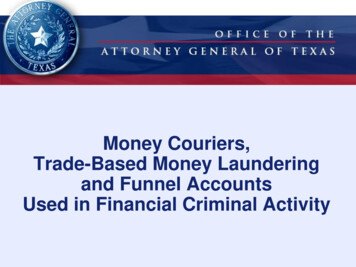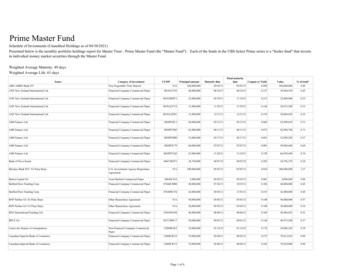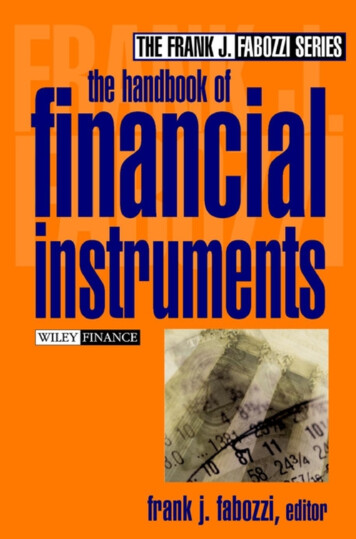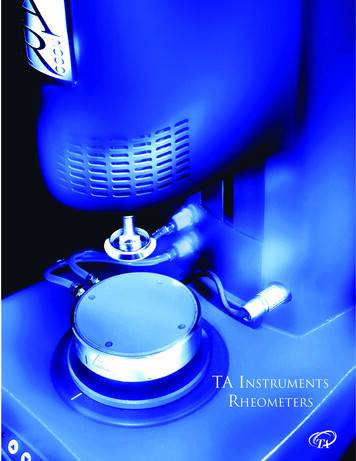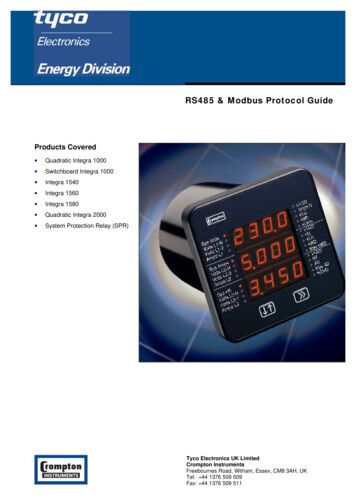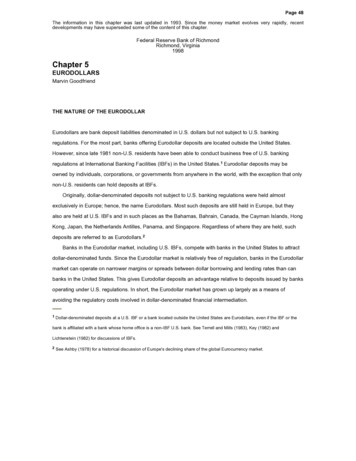
Transcription
Page 48The information in this chapter was last updated in 1993. Since the money market evolves very rapidly, recentdevelopments may have superseded some of the content of this chapter.Federal Reserve Bank of RichmondRichmond, Virginia1998Chapter 5EURODOLLARSMarvin GoodfriendTHE NATURE OF THE EURODOLLAREurodollars are bank deposit liabilities denominated in U.S. dollars but not subject to U.S. bankingregulations. For the most part, banks offering Eurodollar deposits are located outside the United States.However, since late 1981 non-U.S. residents have been able to conduct business free of U.S. bankingregulations at International Banking Facilities (IBFs) in the United States.1 Eurodollar deposits may beowned by individuals, corporations, or governments from anywhere in the world, with the exception that onlynon-U.S. residents can hold deposits at IBFs.Originally, dollar-denominated deposits not subject to U.S. banking regulations were held almostexclusively in Europe; hence, the name Eurodollars. Most such deposits are still held in Europe, but theyalso are held at U.S. IBFs and in such places as the Bahamas, Bahrain, Canada, the Cayman Islands, HongKong, Japan, the Netherlands Antilles, Panama, and Singapore. Regardless of where they are held, suchdeposits are referred to as Eurodollars. 2Banks in the Eurodollar market, including U.S. IBFs, compete with banks in the United States to attractdollar-denominated funds. Since the Eurodollar market is relatively free of regulation, banks in the Eurodollarmarket can operate on narrower margins or spreads between dollar borrowing and lending rates than canbanks in the United States. This gives Eurodollar deposits an advantage relative to deposits issued by banksoperating under U.S. regulations. In short, the Eurodollar market has grown up largely as a means ofavoiding the regulatory costs involved in dollar-denominated financial intermediation.1 Dollar-denominated deposits at a U.S. IBF or a bank located outside the United States are Eurodollars, even if the IBF or thebank is affiliated with a bank whose home office is a non-IBF U.S. bank. See Terrell and Mills (1983), Key (1982) andLichtenstein (1982) for discussions of IBFs.2 See Ashby (1978) for a historical discussion of Europe's declining share of the global Eurocurrency market.
Page 49THE SIZE OF THE EURODOLLAR MARKETEurodollar volume is measured as the dollar-denominated deposit liabilities of banks located outside theUnited States. For example, the Bank for International Settlements (BIS) defines and measures Eurodollarsas dollars that have "been acquired by a bank outside the United States and used directly or afterconversion into another currency for lending to a nonbank customer, perhaps after one or more redepositsfrom one bank to another." 3The sum of all dollar-denominated liabilities of banks outside the United States measures the gross sizeof the Eurodollar market. For some purposes, it is useful to net some interbank deposits out of the gross toarrive at an estimate of Eurodollar deposits held by original suppliers to the Eurodollar market. Roughlyspeaking, to construct the net size measure, deposits owned by banks in the Eurodollar market are nettedout. But deposits owned by banks located outside of the Eurodollar market area are not netted out becausethese banks are considered to be original suppliers of funds to the Eurodollar market. For still otherpurposes, such as comparing the volume of deposits created in the Eurodollar market with the U.S.monetary aggregates, it is useful to further net out all bank-owned Eurodollar deposits. Doing so leaves onlythe nonbank portion of the net size measure, or what might be called the net-net size of the Eurodollarmarket.The most readily accessible estimates of the size of the Eurodollar market were compiled by MorganGuaranty Trust Company of New York and reported in its monthly bank letter, World Financial Markets.4Morgan's estimates included data compiled by the BIS. However, Morgan's estimates were somewhat morecomprehensive. Morgan reported estimates of the size of the entire Eurocurrency market based roughly onall foreign-currency liabilities of banks in major European countries, nine other market areas, and U.S. IBFs.Morgan stopped publishing its Euromarket data in 1988.As of March 1988 Morgan estimated the gross size of the Eurocurrency market at 4,561 billion; the netsize was put at 2,587 billion.5 Morgan also reported that Eurodollars made up 67 percent of grossEurocurrency liabilities, putting the gross size of the Eurodollar market at 3,056 billion.6 No net size3 Bank for International Settlements 1964, p. 127. In principle, today the definition includes acquisitions by IBFs.4 See Morgan Guaranty (January 1979, pp. 9-13) for a discussion of Morgan's method of measuring the size of the Eurodollarmarket. Other informative discussions of issues involved in measuring the Eurodollar market's size are found in Dufey and Giddy(1978, pp. 21-34) and Mayer (1976).5 Morgan Guaranty, November 1988, p. 13. Most of the growth of the Eurocurrency market has occurred in the last two decades.Dufey and Giddy (1978, p. 22) reports Morgan's earliest estimate of the gross size of the Eurocurrency market as only 20 billionin 1964. See Dufey and Giddy (1978, Chap. III) for a discussion of the growth of the Eurocurrency market. On the net size, seeMorgan Guaranty (November 1988, p. 13).6 Ibid.
Page 50for the Eurodollar market was given. However, 67 percent of the net size of the Eurocurrency market yields 1,733 billion as an approximate measure of the net size of the Eurodollar market.M2 is the narrowest U.S. monetary aggregate that includes some Eurodollar deposits. M2 includesovernight Eurodollar deposits held by U.S. residents other than depository institutions and money marketfunds at branches of U.S. banks worldwide. As of May 1991, M2 measured 3,396 billion; its Eurodollarcomponent was 17.8 billion.7 This comparison shows clearly that Eurodollar deposits account for arelatively small portion of monetary assets held by U.S. residents.INCENTIVES FOR DEVELOPMENTOF THE EURODOLLAR MARKET8By accepting dollar-denominated deposits and making dollar-denominated loans outside the United Statesand at U.S. IBFs, banks avoid some U.S. banking regulations. For example, IBFs and banks located outsidethe United States do not have to hold noninterest-bearing required reserves against their dollar-denominateddeposits. Recently, reserve requirements have been eliminated on all time deposits in the United States andhave been reduced from 12 to 10 percent on transactions deposits. However, U.S. bank regulations havebeen strengthened as a result of the banking problems encountered in the 1980s. Regulatory initiatives suchas stricter capital standards, higher deposit insurance premiums, and more intense supervisory scrutinyhave raised the cost of depository intermediation in the United States.Eurodollar banks hold balances with banks in the United States for clearing purposes only andotherwise avoid reserve requirements. Moreover, there is no deposit insurance assessment on Eurodollars.Although stricter capital standards also have been imposed internationally, the regulatory cost of depositoryintermediation in the United States remains higher than in the Eurodollar market.In most Eurodollar financial centers, entry into Eurodollar banking is virtually free of regulatoryimpediments, so banks intending to do Eurodollar business can easily set up in locations where tax rates arelow. For example, Eurodollar deposits and loans negotiated in London or elsewhere often are booked inlocations such as Nassau and the Cayman Islands to obtain more favorable tax treatment. In addition,various states in the United States have amended their tax codes to grant IBFs relief from local taxes.7 Board of Governors of the Federal Reserve System 1991, pp. 1 and 7. At present, Eurodollars held by non-U.S. residents arenot included in any of the U.S. monetary aggregates. As improved data sources become available, the possible inclusion ofEurodollars held by non-U.S. residents other than banks and official institutions could be reviewed. See Board of Governors ofthe Federal Reserve System (1980, p. 98).8 See Dufey and Giddy (1978, pp. 110-12) for a historical discussion of the conditions that made large-scale growth of theEurodollar market possible.
Page 51Foreign monetary authorities generally are reluctant to regulate Eurodollar business because to do sowould drive the business away, denying the host country income, tax revenue, and jobs. Even if the U.S.monetary authorities could induce a group of foreign countries to participate in a plan to regulate theirEuromarkets, such a plan would be ineffective unless every country agreed not to host unregulatedEurodollar business. In practice, competition for such business has been fierce, so even if a consensusshould develop in the United States to regulate Eurodollar business, it would be extremely difficult to imposeregulations on the entire Eurodollar market.INSTRUMENTS OF THE EURODOLLAR MARKET 9The overwhelming majority of money in the Eurodollar market is held in fixed-rate time deposits (TDs). Thematurities range from overnight to several years, although most are from one week to six months. Eurodollartime deposits are intrinsically different from dollar deposits held at banks in the United States only in that theformer are liabilities of IBFs or of banks located outside the United States. The bulk of Eurodollar TDs areinterbank liabilities. They pay a fixed, competitively determined rate of return.10Another important Eurodollar instrument is the Eurodollar certificate of deposit (CD). Essentially, aEurodollar CD is a negotiable receipt for a dollar deposit at a bank located outside the United States or in aU.S. IBF. From their introduction in 1966, the volume of Eurodollar CDs outstanding reached roughly 50billion at the beginning of 1980.11 By late 1990, Eurodollar CD volume was around 130 billion. The 1990elimination of the 3 percent reserve requirement on nonpersonal time deposits and CDs in the United Stateshas made the Eurodollar CD market a bit less active. As of spring 1992, volume had fallen to around 116billion.Recently, fixed-rate, three-month Eurodollar CDs have yielded approximately 10 basis points below thethree-month London Interbank Offered Rate (LIBOR). 12 LIBOR is the rate at which major international banksare willing to offer term Eurodollar deposits to each other. An active secondary market allows9 Bank for International Settlements (1986, Chaps. 1 and 4), Dobbs-Higginson (1980, pp. 55-61), Dufey and Giddy (1978, pp.228-32), and Stigum (1990, Chaps. 7, 18, 20, and 22) contain informative discussions of Eurodollar instruments.10 See Stigum (1990, pp. 890-93) and Dufey and Giddy (1978, p. 227) for discussions of the tiering of Eurodollar deposit ratesaccording to the perceived creditworthiness of issuing banks. The Banker (1987) has a discussion of tiering in the Euro-CDmarket.11 Bank of England, Financial Statistics Division, International Banking Group. This data includes all London foreign currencyCDs. Almost all Euro CDs are issued in London, however, and almost all of these are denominated in dollars. Early descriptionsof the London dollar CD market are found in Credit Suisse (1980) and "The London Dollar CD" (1973).12 This spread was calculated using data in Salomon Brothers (1990) and the DRI database.
Page 52investors to sell Eurodollar CDs before the deposits mature. Secondary market makers' spreads for shortterm fixed-rate CDs have been 1 to 3 basis points for European bank dollar CDs and around 5 basis pointsfor Japanese bank dollar CDs.13Eurodollar CDs are issued by banks to "tap" the market for funds and are commonly issued indenominations of from 250,000 to 5 million. Some Eurodollar CDs, called Tranche CDs, are issued in verylarge denominations but marketed in several portions in order to satisfy investors with preferences forsmaller instruments. The latter are issued in aggregate amounts of 10 million to 30 million and are offeredby banks to individual investors in 10,000 certificates, with each certificate having the same interest rate,issue date, interest payment dates, and maturity.In the late 1970s Eurodollar floating-rate CDs (FRCDs) and Eurodollar floating-rate notes (FRNs) cameinto use as means of protecting both borrower and lender against interest rate risk. By making their couponpayments float with market interest rates, these "floaters" stabilize the principal value of the paper. Themarket for FRCDs is no longer active. The volume of FRNs outstanding fell from 125 in 1986 to 116 in1990.14Eurodollar FRNs have been issued in maturities from 4 to 20 years, with the majority of issuesconcentrated in the five- to seven-year range. Eurodollar FRNs tend to be seen as an alternative to straightfixed-interest bonds, but they can in principle be used like FRCDs. Eurodollar FRNs have been issuedprimarily by banks and sovereign governments. FRNs issued by governments are not Eurodollars propersince they are not bank liabilities. Strictly speaking, they should be referred to as Eurodollar instrumentstogether with the NIFs and Euro commercial paper discussed below.Eurodollar FRCDs and FRNs are both negotiable bearer paper. The coupon or interest rate on theseinstruments is reset relative to the corresponding LIBOR every three or six months. The rate is set belowLIBOR for sovereign borrowers and above for U.S. banks. Yields on Eurodollar FRNs range from 1/8percent under the London Interbank Bid Rate (LIBID) up to LIBOR.15 To determine LIBOR for EurodollarFRNs, "the issuer chooses an agent bank who in turn polls three or four Reference Banks—generally, theLondon offices of major international banks. Rates are those prevailing at 11:00 a.m. London time twobusiness days prior to the commencement of the next coupon period.
Eurodollar CD is a negotiable receipt for a dollar deposit at a bank located outside the United States or in a U.S. IBF. From their introduction in 1966, the volume
